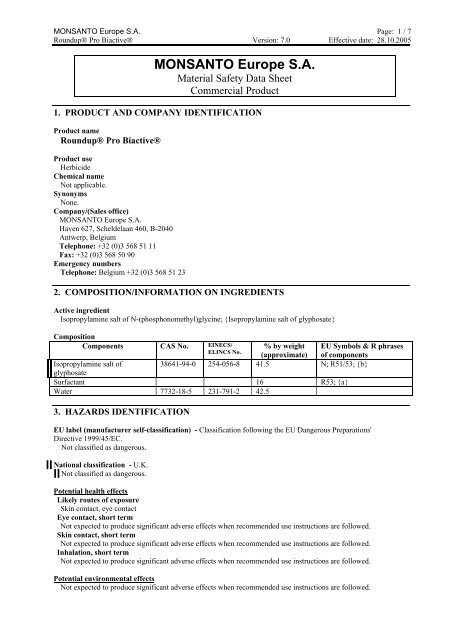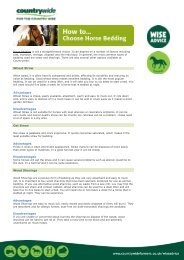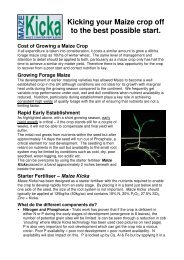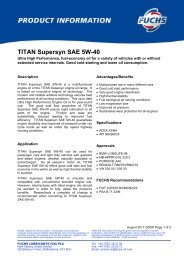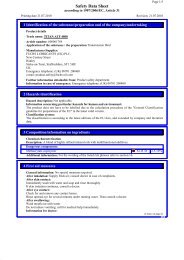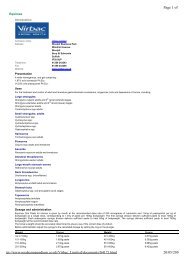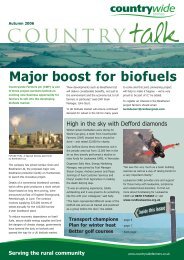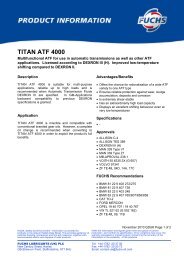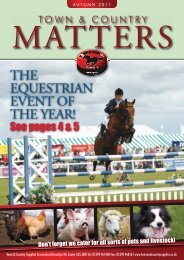Roundup Pro Biactive MSDS
Roundup Pro Biactive MSDS
Roundup Pro Biactive MSDS
- No tags were found...
Create successful ePaper yourself
Turn your PDF publications into a flip-book with our unique Google optimized e-Paper software.
MONSANTO Europe S.A. Page: 1 / 7<strong>Roundup</strong>® <strong>Pro</strong> <strong>Biactive</strong>® Version: 7.0 Effective date: 28.10.2005MONSANTO Europe S.A.Material Safety Data SheetCommercial <strong>Pro</strong>duct1. PRODUCT AND COMPANY IDENTIFICATION<strong>Pro</strong>duct name<strong>Roundup</strong>® <strong>Pro</strong> <strong>Biactive</strong>®<strong>Pro</strong>duct useHerbicideChemical nameNot applicable.SynonymsNone.Company/(Sales office)MONSANTO Europe S.A.Haven 627, Scheldelaan 460, B-2040Antwerp, BelgiumTelephone: +32 (0)3 568 51 11Fax: +32 (0)3 568 50 90Emergency numbersTelephone: Belgium +32 (0)3 568 51 232. COMPOSITION/INFORMATION ON INGREDIENTSActive ingredientIsopropylamine salt of N-(phosphonomethyl)glycine; {Isopropylamine salt of glyphosate}CompositionComponents CAS No. EINECS/ % by weight EU Symbols & R phrasesELINCS No.(approximate) of componentsIsopropylamine salt of38641-94-0 254-056-8 41.5 N; R51/53; {b}glyphosateSurfactant 16 R53; {a}Water 7732-18-5 231-791-2 42.53. HAZARDS IDENTIFICATIONEU label (manufacturer self-classification) - Classification following the EU Dangerous Preparations'Directive 1999/45/EC.Not classified as dangerous.National classification - U.K.Not classified as dangerous.Potential health effectsLikely routes of exposureSkin contact, eye contactEye contact, short termNot expected to produce significant adverse effects when recommended use instructions are followed.Skin contact, short termNot expected to produce significant adverse effects when recommended use instructions are followed.Inhalation, short termNot expected to produce significant adverse effects when recommended use instructions are followed.Potential environmental effectsNot expected to produce significant adverse effects when recommended use instructions are followed.
MONSANTO Europe S.A. Page: 2 / 7<strong>Roundup</strong>® <strong>Pro</strong> <strong>Biactive</strong>® Version: 7.0 Effective date: 28.10.2005Refer to section 11 for toxicological and section 12 for environmental information.4. FIRST AID MEASURESEye contactImmediately flush with plenty of water.If easy to do, remove contact lenses.Skin contactTake off contaminated clothing, wristwatch, jewellery.Wash affected skin with plenty of water.Wash clothes and clean shoes before re-use.InhalationRemove to fresh air.IngestionImmediately offer water to drink.Never give anything by mouth to an unconscious person.Do NOT induce vomiting unless directed by medical personnel.If symptoms occur, get medical attention.Advice to doctorsThis product is not an inhibitor of cholinesterase.AntidoteTreatment with atropine and oximes is not indicated.5. FIRE-FIGHTING MEASURESFlash pointDoes not flash.Extinguishing mediaRecommended: Water, foam, dry chemical, carbon dioxide (CO2)Unusual fire and explosion hazardsMinimise use of water to prevent environmental contamination.Environmental precautions: see section 6.Hazardous products of combustionCarbon monoxide (CO), phosphorus oxides (PxOy), nitrogen oxides (NOx)Fire fighting equipmentSelf-contained breathing apparatus.Equipment should be thoroughly decontaminated after use.6. ACCIDENTAL RELEASE MEASURESPersonal precautionsUse personal protection recommended in section 8.Environmental precautionsSMALL QUANTITIES:Low environmental hazard.LARGE QUANTITIES:Minimise spread.Keep out of drains, sewers, ditches and water ways.Notify authorities.
MONSANTO Europe S.A. Page: 3 / 7<strong>Roundup</strong>® <strong>Pro</strong> <strong>Biactive</strong>® Version: 7.0 Effective date: 28.10.2005Methods for cleaning upPlace leaking containers in oversize leakproof drums for transport.SMALL QUANTITIES:Flush spill area with water.LARGE QUANTITIES:Absorb in earth, sand or absorbent material.Dig up heavily contaminated soil.Collect in containers for disposal.Refer to section 7 for types of containers.Flush residues with small quantities of water.Minimise use of water to prevent environmental contamination.Refer to section 13 for disposal of spilled material.7. HANDLING AND STORAGEGood industrial practice in housekeeping and personal hygiene should be followed.HandlingWhen using do not eat, drink or smoke.Wash hands thoroughly after handling or contact.Wash contaminated clothing before re-use.Thoroughly clean equipment after use.Do not contaminate drains, sewers and water ways when disposing of equipment rinse water.Refer to section 13 for disposal of rinse water.Emptied containers retain vapour and product residue.FOLLOW LABELLED WARNINGS EVEN AFTER CONTAINER IS EMPTIED.StorageMinimum storage temperature: -15 °CMaximum storage temperature: 50 °CCompatible materials for storage: stainless steel, aluminium, fibreglass, plastic, glass liningIncompatible materials for storage: galvanised steel, unlined mild steel, see section 10.Keep out of reach of children.Keep away from food, drink and animal feed.Keep only in the original container.Partial crystallization may occur on prolonged storage below the minimum storage temperature.If frozen, place in warm room and shake frequently to put back into solution.Minimum shelf life: 5 years.8. EXPOSURE CONTROLS/PERSONAL PROTECTIONAirborne exposure limitsComponentsIsopropylamine salt of glyphosateSurfactantWaterExposure GuidelinesNo specific occupational exposure limit has been established.No specific occupational exposure limit has been established.No specific occupational exposure limit has been established.Engineering controlsNo special requirement when used as recommended.Eye protectionNo special requirement when used as recommended.Skin protectionIf repeated or prolonged contact:
MONSANTO Europe S.A. Page: 4 / 7<strong>Roundup</strong>® <strong>Pro</strong> <strong>Biactive</strong>® Version: 7.0 Effective date: 28.10.2005Wear chemical resistant gloves.Respiratory protectionNo special requirement when used as recommended.When recommended, consult manufacturer of personal protective equipment for the appropriate type ofequipment for a given application.9. PHYSICAL AND CHEMICAL PROPERTIESThese physical data are typical values based on material tested but may vary from sample to sample. Typicalvalues should not be construed as a guaranteed analysis of any specific lot or as specifications for the product.Colour/colour range:Yellowish - BrownForm:LiquidOdour:EarthyBoiling point: 105.3 °CFlash point:Does not flash.Specific gravity: 1.17 @ 20 °C / 4 °CDynamic viscosity:65 mPa·sSolubility:Water: Completely miscible.pH:4.6 - 5.0 @ 80 g/lPartition coefficient (log Pow): -3.2 @ 25 °C (glyphosate)10. STABILITY AND REACTIVITYStabilityStable under normal conditions of handling and storage.Hazardous decompositionThermal decomposition: Hazardous products of combustion: see section 5.Materials to avoid/ReactivityReacts with galvanised steel or unlined mild steel to produce hydrogen, a highly flammable gas that couldexplode.11. TOXICOLOGICAL INFORMATIONThis section is intended for use by toxicologists and other health professionals.Data obtained on product and components are summarized below.Acute oral toxicityRat, LD50: > 5,000 mg/kg body weightNo mortality.Acute dermal toxicityRat, LD50: > 5,000 mg/kg body weightNo mortality.Skin irritationRabbit, 6 animals, OECD 404 test:Redness, mean EU score: 0.11Swelling, mean EU score: 0.00Days to heal: 3Eye irritationRabbit, 6 animals, OECD 405 test:Conjunctival redness, mean EU score: 1.11Conjunctival swelling, mean EU score: 0.00Corneal opacity, mean EU score: 0.00Iris lesions, mean EU score: 0.00
MONSANTO Europe S.A. Page: 5 / 7<strong>Roundup</strong>® <strong>Pro</strong> <strong>Biactive</strong>® Version: 7.0 Effective date: 28.10.2005Days to heal: 7Skin sensitizationGuinea pig, 9-induction Buehler test:Positive incidence: 0 %N-(phosphonomethyl)glycine; {glyphosate}MutagenicityIn vitro and in vivo mutagenicity test(s):Not mutagenic.Repeated dose toxicityRabbit, dermal, 21 days:NOAEL toxicity: > 5,000 mg/kg body weight/dayTarget organs/systems: noneOther effects: noneRat, oral, 3 months:NOAEL toxicity: > 20,000 mg/kg dietTarget organs/systems: noneOther effects: noneChronic effects/carcinogenicityMouse, oral, 24 months:NOEL tumour: > 30,000 mg/kg dietNOAEL toxicity: ~ 5,000 mg/kg dietTumours: noneTarget organs/systems: liverOther effects: decrease of body weight gain, histopathologic effectsRat, oral, 24 months:NOEL tumour: > 20,000 mg/kg dietNOAEL toxicity: ~ 8,000 mg/kg dietTumours: noneTarget organs/systems: eyesOther effects: decrease of body weight gain, histopathologic effectsToxicity to reproduction/fertilityRat, oral, 2 generations:NOAEL toxicity: 10,000 mg/kg dietNOAEL reproduction: > 30,000 mg/kg dietTarget organs/systems in parents: noneOther effects in parents: decrease of body weight gainTarget organs/systems in pups: noneOther effects in pups: decrease of body weight gainEffects on offspring only observed with maternal toxicity.Developmental toxicity/teratogenicityRat, oral, 6 - 19 days of gestation:NOAEL toxicity: 1,000 mg/kg body weightNOAEL development: 1,000 mg/kg body weightOther effects in mother animal: decrease of body weight gain, decrease of survivalDevelopmental effects: weight loss, post-implantation loss, delayed ossificationEffects on offspring only observed with maternal toxicity.Rabbit, oral, 6 - 27 days of gestation:NOAEL toxicity: 175 mg/kg body weightNOAEL development: 175 mg/kg body weightTarget organs/systems in mother animal: noneOther effects in mother animal: decrease of survivalDevelopmental effects: none12. ECOLOGICAL INFORMATIONThis section is intended for use by ecotoxicologists and other environmental specialists.Data obtained on product and components are summarized below.
MONSANTO Europe S.A. Page: 6 / 7<strong>Roundup</strong>® <strong>Pro</strong> <strong>Biactive</strong>® Version: 7.0 Effective date: 28.10.2005Aquatic toxicity, fishRainbow trout (Oncorhynchus mykiss):Acute toxicity, 96 hours, flowthrough, LC50: > 989 mg/LCommon carp (Cyprinus carpio):Acute toxicity, 96 hours, flowthrough, LC50: > 895 mg/LAquatic toxicity, invertebratesWater flea (Daphnia magna):Acute toxicity, 48 hours, flowthrough, EC50: 676 mg/LAquatic toxicity, algae/aquatic plantsGreen algae (Selenastrum capricornutum):Acute toxicity, 72 hours, static, ErC50 (growth rate): 393 mg/LAvian toxicityMallard duck (Anas platyrhynchos):Dietary toxicity, 5 days, LC50: > 5,620 mg/kg dietBobwhite quail (Colinus virginianus):Dietary toxicity, 5 days, LC50: > 5,620 mg/kg dietArthropod toxicityHoney bee (Apis mellifera):Oral, 48 hours, LD50: > 254 µg/beeHoney bee (Apis mellifera):Contact, 48 hours, LD50: > 330 µg/beeSoil organism toxicity, invertebratesEarthworm (Eisenia foetida):Acute toxicity, 14 days, LC50: > 1,250 mg/kg dry soilSoil organism toxicity, microorganismsNitrogen and carbon transformation test:53 L/ha, 28 days: Less than 25% effect on nitrogen or carbon transformation processes in soil.N-(phosphonomethyl)glycine; {glyphosate}BioaccumulationBluegill sunfish (Lepomis macrochirus):Whole fish: BCF: < 1No significant bioaccumulation is expected.DissipationSoil, field:Half life: 2 - 174 daysKoc: 884 - 60,000 L/kgAdsorbs strongly to soil.Water, aerobic:Half life: < 7 days13. DISPOSAL CONSIDERATIONS<strong>Pro</strong>ductRecycle if appropriate facilities/equipment available.Burn in special, controlled high temperature incinerator.Dispose of as hazardous industrial waste.Keep out of drains, sewers, ditches and water ways.Follow all local/regional/national/international regulations.ContainerTriple or pressure rinse empty containers.Pour rinse water into spray tank.Store for collection by approved waste disposal service.Dispose of as non hazardous industrial waste.Do NOT re-use containers.Follow all local/regional/national/international regulations.14. TRANSPORT INFORMATION
MONSANTO Europe S.A. Page: 7 / 7<strong>Roundup</strong>® <strong>Pro</strong> <strong>Biactive</strong>® Version: 7.0 Effective date: 28.10.2005The data provided in this section is for information only. Please apply the appropriate regulations to properlyclassify your shipment for transportation.Not regulated for transport.15. REGULATORY INFORMATIONEU label (manufacturer self-classification) - Classification following the EU Dangerous Preparations'Directive 1999/45/EC.Not classified as dangerous.National classification - U.K.Not classified as dangerous.16. OTHER INFORMATIONThe information given here is not necessarily exhaustive but is representative of relevant, reliable data.Follow all local/regional/national/international regulations.Please consult supplier if further information is needed.This Safety Data Sheet has been prepared following the EU Directive 91/155/EEC as last amended by EUDirective 2001/58/EC.In this document the British spelling was applied.® Registered trademark.|| Changes versus previous edition.EU Symbols & R phrases of componentsComponentsEU Symbols & R phrases of componentsIsopropylamine salt of glyphosate N - Dangerous for the environmentR51/53 Toxic to aquatic organisms, may cause long-term adverse effects in the aquatic environment.SurfactantR53 May cause long-term adverse effects in the aquatic environment.WaterEndnotes:{a} EU label (manufacturer self-classification){b} EU label (Annex I){c} National classificationFull denomination of most frequently used acronyms. BCF (Bioconcentration Factor), BOD (Biochemical Oxygen Demand), COD(Chemical Oxygen Demand), EC50 (50% effect concentration), ED50 (50% effect dose), I.M. (intramuscular), I.P. (intraperitoneal), I.V.(intravenous), Koc (Soil adsorption coefficient), LC50 (50% lethality concentration), LD50 (50% lethality dose), LDLo (Lower limit of lethaldosage), LEL (Lower Explosion Limit), LOAEC (Lowest Observed Adverse Effect Concentration), LOAEL (Lowest Observed AdverseEffect Level), LOEC (Lowest Observed Effect Concentration), LOEL (Lowest Observed Effect Level), MEL (Maximum Exposure limit),MTD (Maximum Tolerated Dose), NOAEC (No Observed Adverse Effect Concentration), NOAEL (No Observed Adverse Effect Level),NOEC (No Observed Effect Concentration), NOEL (No Observed Effect Level), OEL (Occupational Exposure Limit), PEL (PermissibleExposure Limit), PII (Primary Irritation Index), Pow (Partition coefficient n-octanol/water), S.C. (subcutaneous), STEL (Short-TermExposure Limit), TLV-C (Threshold Limit Value-Ceiling), TLV-TWA (Threshold Limit Value - Time Weighted Average), UEL (UpperExplosion Limit)000000005051Although the information and recommendations set forth herein (hereinafter "Information") arepresented in good faith and believed to be correct as of the date hereof, MONSANTO Company or anyof its subsidiaries makes no representations as to the completeness or accuracy thereof. Information issupplied upon the condition that the persons receiving same will make their own determination as toits suitability for the purposes prior to use. In no event will MONSANTO Company or any of itssubsidiaries be responsible for damages of any nature whatsoever resulting from the use of or relianceupon information. NO REPRESENTATIONS OR WARRANTIES, EITHER EXPRESS ORIMPLIED, OF MERCHANTABILITY, FITNESS FOR A PARTICULAR PURPOSE OR OF ANYOTHER NATURE ARE MADE HEREUNDER WITH RESPECT TO INFORMATION OR TO THEPRODUCT TO WHICH INFORMATION REFERS.


